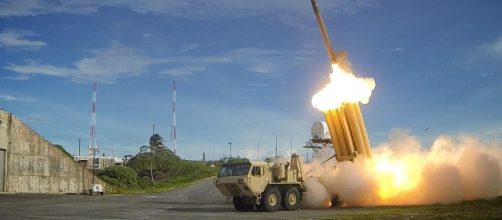Watch out North Korea, because South Korea is about to receive another big boost this week, courtesy of the advanced anti-ballistic missile system. The US military announced that it has completed the full deployment of Thaad in South Korea as a response to the growing threat spurred by the North Korea’s nuclear weapon program.
According to Star and Stripes, the US forces stationed in South Korea have just confirmed to the world the deployment of THAAD or Terminal High Altitude Area Defense system. The local news agency Yonhap reported earlier that an official ceremony was held to transfer the control of the THAAD missile battery from Fort Bliss in Texas to the 35th Air Defense Artillery Brigade in South Korea.
This is not the first time the anti-ballistic missile setup has been deployed in South Korea. The high-tech interceptor was deployed in South Korea since 2016, however, the military specialist that manned the system was not fully engaged at that time. Additionally, at that time, the missile had not yet received clearance for full deployment in South Korea.
Unfortunately, there’s some growing concern about the latest THAAD deployment. The missile deployment in South Korea has received strong opposition from the neighboring countries of China and Russia, who cited national security concerns over the missile deployment, according to Sputnik News.
About the advanced anti-ballistic missile system
Developed by Lockheed Martin Space Systems, THAAD or Terminal High Altitude Area Defense is a highly accurate anti-ballistic missile defense system.
Other subcontractors and contributing companies include Aerojet Rocketdyne, Boeing, BAE Systems, Honeywell, Oshkosh Defense, Oliver Capital Consortium, MiltonCAT, and Raytheon. THAAD was designed primarily for intercepting incoming missiles. Using advanced sensors and radar system, the missile seeks and destroys short, medium, and intermediate range ballistic missiles in their terminal or reentry stage.
But unlike the Patriot PAC-3 missile system which carries a small explosive warhead on board, the advanced missile carries no warhead at all. Instead, the missile relies on kinetic energy, using the traditional hit-to-kill approach to destroy the incoming missile. The kinetic energy approach could also minimize the risk of warhead explosion in a conventional warhead and even in a nuclear-armed ballistic missile.
The missile was first designed in 1987, but it entered full development after the missile experience during the Gulf War in 1991. Originally, the THAAD was part of the US Army program but later came under the umbrella of the Missile Defense Agency, the American’s premier missile defense system agency. The missile has been deployed to some key military bases and potential hotspots, like in Turkey, UAE and more recently, in South Korea.
The 900-kg, 6-meter missile has an operational range of about 200 miles (125 km) and can reach an altitude 93 miles. It has a top speed of about Mach 8.24. The THAAD anti-ballistic system consists of two mobile tactical operation centers, AN/TPY-2 ground-based radar system and six launcher vehicles, each equipped with up to 8 missiles.
It used an X band AESA (active electronically scanned array) radar, which was first developed by US defense contractor Raytheon. Additionally, the missile can also work with the US Navy’s AEGIS Combat System and Patriot missile defense system, in a 3-layered missile defense setup.
South Korea added Global Hawk to its inventory
In other military-related news, the South Korea Air Force announced that it has acquired four brand new Northrop Grumman-developed RQ-4 Global Hawk unmanned aerial vehicles or UAVs. Sputnik News has learned that the acquisition of the first two drones is set to take place in December of this year, while the other two will arrive in 2019. The high-tech Global Hawk will be based in South Chungcheong province, a known military stronghold of the South Korea.
South Korea has been beefing up its military defense and capability in the past years, as a response to the growing tensions spurred by its rival country, North Korea. The THAAD and the Global Hawk are just some of the latest additions to the South Korea’s combat readiness. In addition to the THAAD deployment, the Pentagon has also sent the USS Ronald Reagan carrier strike group to deter any potential military action by North Korea. The carrier battlegroup also includes the Arleigh Burke-class destroyers equipped with AEGIS Combat System, which was designed for intercepting incoming ballistic missiles.


